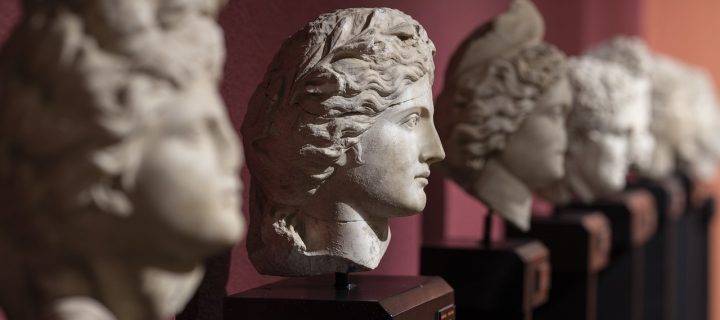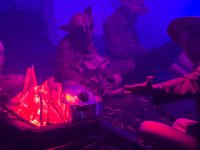Editorial note: This article was originally published in the Knutepunkt 2025 book Anatomy of Larp Thoughts, a breathing corpus. It has been reprinted from there with the editors’ and authors’ permission. It has not been edited by Nordiclarp.org.
The art-larp paradox refers to the tensions between the development of larp as an artform in its own right and adapting to institutionalised arts spaces, compromising on the essence of what makes it art in the first place. Drawing on my experience of Situationist practices and democratised participation models, I will argue that in adapting larp practices to be suitable for artistic spaces and audiences, embodiment, and player agency is susceptible to compromise – potentially sacrificing the artistic essence of larp itself. In order to be more artistic, larp should be less like art and more like larp.
The term ‘art-larp’ is a bit of a red herring. Generally it refers to larp which experiments with form, has a social relevance, or works interdisciplinarily with other artistic genres. Nordic style larp practice often falls into one of these categories, yet sometimes we are reluctant to acknowledge this. As influence flows between larp practices and artistic practices of audience-based media, larp conforming to artistic spaces is fraught with the danger of compromising key aesthetic values.
Art has a tendency to subsume other practices to be included in its definition. If we think of art as an aesthetic form for its own sake which allows the opportunity to think, feel, and experience something outside of the everyday, then it will be undoubtedly rapacious in its appetite of feeding itself from practices which are close to it, including larp.
Art’s habitude for subsumption does not negatively impact larp. However, in combination with the lack of widespread established institutions to legitimise larp and the prevalence of commodification within late-stage capitalism, larp’s cross-pollination with more established artistic practices has the potential to compromise the artistic essence of larp. The closer larp becomes to neighbouring practices, the more susceptible it becomes to compromising on player agency and the physical embodiment of a first-person audience.
Art-larp has a tendency to be pulled towards presenting to non-playing audiences, as viewers. Whether a live audience of non-players with any degree of interactivity in the case of immersive theatre, or a secondary audience who will engage with photography or video work at a later date, both have a similar effect; by creating a passive distance of spectatorship between artwork and viewer, the simultaneous production and reception of a first-person audience is disrupted.
In the case of larp, artworks which modify the mode of engagement to passive reception through visual images mediate the social interaction of larp. This is present in visual media works which use larp such as video art, film, and theatre, as well as photo documentation of larp. The simultaneous production and reception of larp as media with a first-person audience – a personal embodied experience as part of a collective experience – is in danger of being compromised or sacrificed when we also consider the aesthetic experience of a secondary audience. Visual aesthetics possess an immersive function in larp to help players access the fiction more easily, although in cases where artistic design choices serve a secondary audience first and foremost, it is the primary ‘audience’ experience which is jeopardised; the players of the larp.
In their essay ‘On The Commodification of Larp’ (2019), Usva Seregina mentions the trends within larp to document through photography and film. In doing so, there is a shift in the ephemeral nature of the work which lives through the documentation as ersatz representation, thus beginning ‘to condense and fragment the live performance, freezing it in time to concretize its meaning’. This is not to say it happens more or less with the disputed genre of ‘art-larp’, but visual documentation is a form of social capital which can be encouraged by presenting work in both overlapping contexts as art and as larp.
According to Seregina, this is a more subtle form of commodification, eclipsed by how we engage with larp as consumers more generally. Seregina’s view is that individualising a collective experience becomes synonymous with consumer choice. The processes of individualisation and the mediation of larp through visual representation appear entangled, potentially having a far more detrimental consequence upon the collective social relations of larp.
In thinking critically about in-game social interaction altered through the consideration of aesthetics designed for secondary audiences, there are social effects beyond the magic circle. Larp is a reality when it is played, albeit temporary within the social frame of larp (Järvelä p.23). This is an important framing; how we interact in the reality of larp has sociological implications.
Considering this, larp’s ephemeral state of performance to a first-person audience is altered by aesthetic interactions with the larp which are outside the scope of participating as a player with the fullest agency to affect outcomes. Rescinding agency to visual modes results in a process of alienation: interaction is mediated through the aesthetic, the viewer as a passive consumer is susceptible to being alienated from the real aesthetic of larp – improvised and embodied co-creation. Primarily this affects in-game interaction but in the sense that we are the characters we play, this also has repercussions beyond the magic circle.
A confrontation and resistance to the process of alienation in the field of art is integral to theory and practice of the Situationist International (SI). In Society of the Spectacle, Guy Debord (1967) argues that passive spectatorship commodifies social roles and relations, and social interaction becomes mediated through visual images.
The dogmatic approach in the manifesto of the Situationist International (SI) describes the active construction of ‘situations’ as a tool for the liberation of everyday life (Debord, 1957). What the SI aimed for in the transformative process of the ‘situation’ was a reaction against the alienation of life, concerning work, private property, and the reception of cultural media. In the case of the latter, a passive state of engaging with visual media means the viewer is estranged from cultural life; the theory borrows heavily from Marx’s theory of alienation. In contrast, the embodied experience of situations were liberatory – simultaneously a rehearsal in the social frame of aesthetics and an embodied reality. This prefigures progressive ways of organising and relating, in art and life. The parallels of Situationist and larp practice that I wish to draw attention to are: the temporary suspense of social norms, physical embodiment of the practice through empowered social agency, and the rejection of forms of spectatorship.
Claire Bishop espouses a critique of non-hierarchical participatory art in her book Artificial Hells – rather prioritising aesthetics of ambiguity and antagonism. I do not believe that spaces in which art happens are somehow magically exempt from critique of power structures. Paulo Freire’s writings on education in Pedagogy of The Oppressed is useful in considering how agency matters. He writes and practices in opposition to a banking model of education, where students are empty vessels to be filled up, rather than independent agents of their own destiny, as they are in democratic learning models. This should sound familiar to anyone who has participated in larp activity; this is the agency of co-creation and often greater than the sum of its parts. Just like the passivity of the banking model of education, I believe viewership of larp in other forms of artistic media: visual arts/film/theatre denies the key aesthetics of social agency and co-creation and risks commodifying meaningful social relations of larp activity.
For better and for worse, larp doesn’t have the same institutionalised infrastructure as more established artforms. Its position as a subculture also allows artistic freedom which does not have to follow institutionalised taste patterns. Institutionalisation does allocate time and financial resources towards art making, but at a cost. Larp institutionalising itself usually must fit in the existing model of art reception which rewards artworks that can be commodified, distancing itself from the ephemeral nature of larp, and compromise the social agency of players as co-creators of the artwork. Can these practices still claim to have the liveness which larp’s foundations are built upon? Does the ‘live’ of live action role play then become redundant?
The ‘liveness’ of larp is not only about being present. Those present should be trusted and empowered to have a share in the authorship of their own actions. As players embody the work and the emotional closeness of the experience, they simultaneously create and feel it. The aesthetics of larp are inherently social; they are performative ephemeral interactions which exist between players, (inter-)acting within the diegetic frame, referred to as inter-immersion (Pohjola, 2004). When an artist triangulates to another focus point – to a viewing audience – the reception of larp moves from the result of co-created interaction to a passive alienated state.
Here we arrive at the art-larp paradox. In trying to be more like art – by adapting to existing artistic institutions and familiar modes of audience spectatorship – larp loses its aesthetic value of embodied co-creation. The point of creation and reception – the immediacy of social relations as building blocks of the artwork – become diluted. The immediate emotional reception of the work through the first-person audience is compromised at the cost of a passive relationship to the play aesthetic. Rather than larp activity being simultaneously created and received in a constant state of dynamism, the representation of the larp experience creates concretised meaning, a finished product whose meaning can no longer be in dialogue with its audience.
Nordwall and Widing lament the design optimisation of larp practice in their article ‘Against Design’. They view the well-designed experience product as failing to be in dialogue with wider culture (p.16). I understand their concerns of design related thinking dominating the discourse, but I don’t believe one negates the other: larps can be artistically designed, by means of an open-ended dialogue between larp designer and participants, to address contemporary societal questions. One suggestion they encourage is innovation of the form, which should be handled with care so as not to commodify the experience via means of spectatorship. How can artistic form innovate – continuing the development of art-larp and its relevance to society and institutionalised art spaces – but without giving up the intrinsic aesthetics of co-creation and social agency? What are the conditions for broader artistic experiments which have less of a risk of compromising agency?
A participatory artform occupying this space, which I would find intriguing to move towards, is socially engaged art – or what Grant Kester describes as a ‘dialogical aesthetic’. A key element is ‘a redefinition of the aesthetic experience as durational rather than immediate’ (Kester, p.12). This requires rethinking how we engage with character play, both as players and artistic larp designers, with durational relationality to larps as artworks. This might look like a series with themes that respond to societal issues, coupled with practices of integration. More broadly, integration is understood to be the awareness and openness to affecting change in our lives, beyond the larp itself (Bowman and Hugaas, 2019).
Resisting the art-larp paradox might look like a campaign or series with deeper critical reflection or integration built-in to the work. Maiju Tarpila’s ecological larp trilogy, ‘Kaski’, achieves this successfully by using a durational form, co-creating over a 5 year period. The players revisit the same fiction as a means for exploring ecological attitudes and values of the players (Leppä, 2024). In this approach, it centres the players as active citizens beyond the fiction who are enabled to affect change. As a larp practitioner who feels frustration with the limits to critical reflection and integration of ecological themes in blackbox and chamber larp spaces, allowing time for these processes like in Tarpila’s larps is an attractive prospect.
The art-larp paradox has created diversions for larp’s aesthetics when adapting to existing modes of viewership. Through priviness to the effects of commodification when presenting work to secondary audiences, and being aware of consumer behaviours challenging co-creation, we open up possibilities to affect long-term change. By embracing larp as an artform in its own right, staying strong to co-creation aesthetics and advancing the inclusion of integration models – potentially through durational and dialogical methods – there are means for the paradox to be broken.
References
Bishop, Claire. 2012. Artificial Hells: Participatory Art and the Politics of Spectatorship
Bowman, Sarah & Hugaas, Kjell Hedgard. 2019. Transformative Role Play: Design, Implementation and Integration
Debord, Guy. 1957. Report on the Construction of Situations
Debord, Guy. 1967. Society of the Spectacle
Freire, Paulo. 1970. Pedagogy of the Oppressed
Järvelä, Simo. 2019. ‘How Real Is Larp?’ In Larp Design: Creating Role Play Experiences, edited by Joanna Koljonen, Jaakoo Stenros, Anne Serup Grove
Kester, Grant. 2004. Conversation Pieces: Community and Communication in Modern Art
Leppä, Elli. 2024 ‘Seeds of Hope: How to Intertwine Larp and Ecological Activism’. In Liminal Encounters in Nordic and Nordic Inspired Larp, edited by Kaisa Kangas, Jonne Arjoranta and Ruska Kevätkoski. Helsinki, Finland. Ropecon ry.
Lukacs, Georg. 1923. History and Class Consciousness
Marx, Karl. 1844. Economic Manuscripts of 1844
Nordwall, Andrea and Widing, Gabriel. 2024. ‘Against Design’. In Liminal Encounters in Nordic and Nordic Inspired Larp, edited by Kaisa Kangas, Jonne Arjoranta and Ruska Kevätkoski. Helsinki, Finland. Ropecon ry.
Pohjola, Mike. ‘Autonomous Identities. Immersion as a Tool for Exploring, Empowering and Emancipating Identities’. In Beyond Role and Play: Tools, Toys and Theory for Harnessing the Imagination, edited by Markus Montola and Jaakko Stenros. Ropecon.
Tarpila, Maiju. 2021-24. Kaski trilogy: Roihu, 2021. Tuhka, 2022. Verso, 2024.
Cover image: Photo by Engin Akyurt from Pixabay






